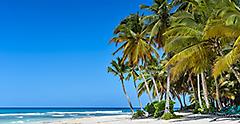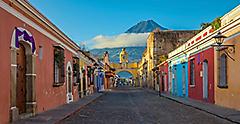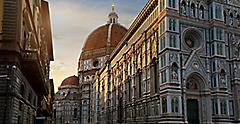
This Caribbean islands trifecta is famous for embracing different cultures and having some of the most iconic vistas in the tropics. Aruba is famous for its lively Caribbean spirit, while Bonaire is known for its quiet and remote vibe, and Curacao has colorful architecture and picture-perfect beaches.
Aruba
Aruba is one of the best Caribbean islands to visit and has a fantastic blend of different cultures that includes indigenous Spanish, African, Dutch, and South American influences. This melting pot is home to close to one hundred nationalities and two official languages, Dutch and Papiamento. Many residents speak even more, including English and Spanish. Aruban culture is all about the spirit of celebration and having an appreciation for the diversity of the island.
You can catch a glimpse of this island medley of cultures in galleries like Unoca, theaters like Cas di Cultura, and places like The National Archaeological Museum Aruba, the Aloe Museum and Factory, and the Arubian Taste Liqueur and Rum Shop. Also stop by Cosecha, a century-old building bursting with local arts and crafts in Oranjestad, and The Creative Center, which is connected to Cosecha and has art classes. Aruba's music is also the result of diverse cultures blending beautifully, with the rhythms including calypso, Tumba, brass and the famous Roadmarch dancing. The latter is seen during carnival month but you can see street festivities, impressive costumes, local music and creative parades all year long. The Bonbini Aruba Festival takes place every Tuesday and offers folkloric music and dance while the Caribbean Festival comes to life every Thursday night with performers, food stands, and crafts. Others include the Dera Gai celebration, the Caribbean Sea Jazz Festival, and the Summer Music Festival during June.
Just like the arts and culture, Aruba's food is a mix of Caribbean, Dutch, African, and Latin American flavors. Fresh seafood, fried delicacies, wholesome stews, and tasty soups are all incorporated. Dishes like pan bati (a sweet and soft flatbread), cabrito stoba (a popular goat stew), and keri keri (a delicious fish soup) are all local staples and easy to find around the island. For drinks, there's beer (the most popular is Balashi) and cocktails like Aruba Ariba, which has a distinctive bright red color. For desserts, go with bolo di banana, a plantain pudding, or with pan bollo, a bread pudding served with rum sauce and a side of vanilla ice cream.
Head to north Aruba to find natural wonders like the Arikok National Park, which has hiking trails and various geological formations, including lava, quartz and limestone. You'll also find some of Aruba's oldest indigenous paintings, made by the Arawaks, as well as gold mines and plantation ruins. Near the park, you can also find Rock Wish Garden, where you can build stone towers that are believed to grant the wishes of those who make them. In the south, you'll find the San Nicolas Bay Reef Islands, which are a perfect place to see the Cayenne tern as well as other tropical birds. Meanwhile, more than 80 species live inside the Bubali Bird Sanctuary, which is close to Eagle Beach.
Aruba is famous for its colorful architecture and you'll find plenty of it on your Southern Caribbean Cruise to Oranjestad, the island's capital. The Dutch buildings house everything from restaurants to shops and bars and allow you to see what it's like to live like a local. You can walk to the lush Wilhelmina Park, which honors Queen Wilhelmina of the Netherlands with a sculpture made with bright white marble, and see the California lighthouse, which is one of Aruba's most famous landmarks. The lighthouse was completed in 1916 after the steamship California wrecked nearby near the end of the nineteenth century. Another architectural must-see is the Old Dutch Windmill, a relic from when Aruba was owned by Holland which is now a popular restaurant.
If you'd like to try Papiamento, start with "con ta bai?" (how are you?), "danki" (thank you), or "hopi bon" (very good). The currency in Aruba is the florin but every establishment on the island accepts US dollars. Tipping is generally optional, though some bars and restaurants include a 10-15% service charge on your bill. And feel free to drink the water from the tap in Aruba — the water is actually one of the cleanest in the world, which comes in handy when dealing with the strong sun on the island. Keep yourself hydrated!
Bonaire
Indian, African, Asian and European inhabitants formed Bonaire and the islanders keep alive many of the traditions brought by settlers. Religious and holiday celebrations are at the heart of Bonaire culture. Their music is a lively collection of tribal sounds, makeshift instruments and modern beats.
On a Southern Caribbean cruise to Bonaire, you'll find flavorful dishes that often involve seafood and goat. Many come with a side of fungi (a type of polenta), rice and beans and plenty of fried plantains, demonstrating the Latin American influence. An African influence can be seen in the island's cuisine as well with dishes like guiambo (a soup made of okra and seafood). Another delicacy you should try is cocada, a sweet coconut dessert made with sugar, vanilla, rose essence, and coconut. For a quintessential Bonaire eating experience, head to Posada Para Mira in Rincon and try the fish balls and iguana stew or try Brass Boer, which features Asian-inspired dishes like their famous avocado with fish and Indonesian spices.
Some of the instruments that Bonaireans crafted are the bari, a drum made with a small rum barrel covered with sheepskin and the chapi, a percussive instrument that was created from the metal end of a hoe and hit with a metal bar. Plow blades, conch shells and even dried donkey jaws with teeth were also used to make musical sounds. The traditional dances in Bonaire are the Bari and the Simadan but locals also enjoy polka, the merengue, the jazz waltz and the carioca. The Bari is performed during festival time with a lead singer improvising lyrics while the Simadan is performed during harvest time, which occurs during the months of February through April.
Bonaire is a nature enthusiast's paradise and conservation efforts are at the forefront of the tourism industry here. Make sure to meet the flamingos of Bonaire at Gotomeer — they're Bonaire's national bird. You should also head to the Washington Slagbaai National Park. It can take a whole day to see it properly so make sure to stop by the visitor center and museum to plan your visit. Bonaire has a whooping 22 beaches to discover and the island offers soft sand beaches as well as rugged coastline. Atlantis Beach is ideal for kiteboarders, white-sand seekers and those looking for a long beach stroll while Te Amo Beach has tranquil waters with a sandy shoreline and great snorkeling nearby. Playa Chikitu, which is located inside the Washington Slagbaai National Park, is a remote cove with white sand dunes, luminescent waters and sea turtle nests. Be careful there because the currents are strong and swimming is not allowed.
Bonaire has a very low risk of tropical storm activity and temperatures usually stay between 73 and 77 degrees Fahrenheit. The hottest season runs from May to October but the trade winds send breezes to the island and the rainy season is short, running from October to December. Pack light cotton clothing and breathable shoes to stay cool. Also, bring plenty of sunblock and always keep a water bottle with you to stay hydrated.
Curaçao
Just like the sister islands in the A-B-C Caribbean island chain, Curaçao is influenced by a variety of cultures but on Curaçao, the Dutch influence is by far the strongest — the island is still a constituent country of the Kingdom of the Netherlands. Papiamento and Dutch are the official languages and English and Spanish are often spoken by locals as well.
Dutch cuisine influences dishes on Curaçao the most, though Afro-Caribbean, Venezuelan and Indonesian influences have also made their way to the Curaçao tables. One of the staples is piska ku funchi, a fresh dish made with polenta, fried plantain and salad. The most popular fish on Curaçao is the red snapper and you'll find many dishes featuring it. Meanwhile, if you're looking for something sweet, try arepa di pampuna, a pumpkin pancake eaten between meals or as a dessert. Pumpkin isn't seasonal on Curaçao so you'll find it as an ingredient in many dishes. You can wash it all down with a Polar or Amstel beer, which are the local favorites.
When it comes to music, Curaçao is known for tumba, a conga-heavy genre that's popular during Carnival period. Dances include waltzes, danzas and mazurkas. Innovations over the decades have included blending the more traditional music with Cuban and Dominican sounds like bolero, merengue and guaracha. You can dance to Curaçao beats in places like Blues Bar, Hofi Fidel and Kokomo Beach.
Willemstad, the capital of Curaçao, is a designated UNESCO World Heritage Site and the candy-colored waterfront town is similar in design and feel to Amsterdam. The airy European plazas, lively markets and artisanal stands add to the vibe of the sunny city while places like Papagayo Hotel feature minimalist designs.
Spots you should see include Christoffelpark, which is a protected park with a peak that's the island's highest at 375 meters above sea level. It houses old plantations, mansion ruins and ancient drawings. You should also visit the Hato Caves, which has stalactites, stalagmites, underground lakes and waterfalls. For beaches, Cas Abao, Playa Lagun, Playa Santa Cruz and Santa Barbara Beach all offer white sandy shores great for swimming, snorkeling or just lounging.
Like the other two islands, Curaçao is hot and it's important to pack accordingly. Comfortable, breathable shoes and light clothing are ideal. To really see the island, it's recommended that you rent a car and you'll need a credit card to do so. Curaçao is considered to be safe but you should always practice common sense and keep your belongings close.












